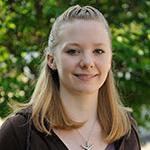
Tamara Thomson: Racetrack Tester
Tamara Thomson, a second-year mechanical engineering major with a minor in mathematics, has worked at the Racing Surfaces Testing Laboratory in Orono since her first year at UMaine.
The Racing Surfaces Testing Laboratory is a nonprofit organization that performs testing of horse racing track surfaces for performance and safety, as well as compares a variety of surfaces used in the industry. The lab’s executive director is Michael “Mick” Peterson, a mechanical engineering professor at UMaine.
Thomson is one of the lab’s primary testers, who has traveled to conduct on-site testing of tracks. She also contributes through training and writing. She was first author of a bulletin written at the lab titled “Predicting Horse Performance on Turf Using Three Commercially Available Monitoring Tools.” She performed all of the statistical analysis for the report.
Thomson has also worked at Biologically Applied Engineering, a corporation organized by Peterson to provide engineering services for research in the biological, veterinary and natural sciences.
Born in Brownsville, Texas, Thomson’s family currently lives in Waite, Maine. She was the valedictorian of her class at Woodland High School in Baileyville, Maine; is a student in the Honors College; and is involved with the Society of Women Engineers (SWE).
Describe Racing Surfaces Testing Laboratory and the work you do there
Working at Racing Surfaces Testing Laboratory has been an amazing experience.
We perform analysis on samples sent from all over North America and the U.K. We look at composition, shear strength, cohesion, etc. and provide data to the tracks so they can better maintain their surfaces.
It might sound mundane, but it’s actually a relatively novel concept; testing of this sort is pretty new to racetrack managers, who have been operating simply with intuition and tradition for hundreds of years.
With the information that the lab provides, we can tell the track managers things like how long it takes for their sand to break down and how their surfaces behave at different temperatures and moisture contents. All of this information helps fine-tune the track maintenance process and ultimately helps make racing safer for horses and jockeys.
Our long-term goal is to create a database containing all the data we have collected over the years. When this goal is realized, comparing track surfaces will be a snap, and data will be easier than ever to analyze.
Describe the work you have done at Biologically Applied Engineering
While Racing Surfaces handles the laboratory testing, Biologically Applied Engineering completes on-site testing. We use the Orono Biomechanical Surface Tester (OBST), which was designed and built by Mick Peterson and his colleagues, as well as ground penetrating radar (GPR) and time domain reflectometry (TDR) to get a better idea of the surfaces’ characteristics during racing.
This past summer, I traveled to Illinois, New York, Kentucky, Ohio and Florida to work on-site. As expected, I learned so much about the mechanics of granular materials, but I also learned a lot about the politics of the racing industry and communication in general.
Why UMaine?
UMaine is the best engineering school in the state, and out-of-state schools are a touch beyond my budget.
Why engineering?
When I was a kid, I decided I would be a wildlife zoologist. Allergies to basically everything outside culled that dream, and I devised a new life plan through the process of elimination.
I knew I needed to find something fascinating that would allow me to secure a job and be financially stable. I don’t like hospitals, and I’m not a great orator, so I ruled out medicine and law.
Engineering was a big category that was left, and it was really the only one that seemed interesting. I picked mechanical engineering because it is the most versatile. From here, I could go on to almost anything.
I’m so pleased with my choice. I have found that I fit in well with the students in my classes, I’m challenged and interested in the curriculum, and I’m very excited to graduate into the field of engineering.
What are your plans for after graduation?
As a student, I haven’t had the opportunity to see all the options that are available yet. I think my best course is to find a job in the engineering field and take some time deciding what I want to focus on before going to graduate school.
What difference has UMaine made in your life and in helping you reach your goals?
UMaine is the institution through which I am learning the skills I will need to support myself for the rest of my life. Beyond that, it’s been a safe place to grow up and figure out how to be an adult. I’ve made a lot of friends that I think will remain close for a long time. It’s definitely the college of my heart always.
